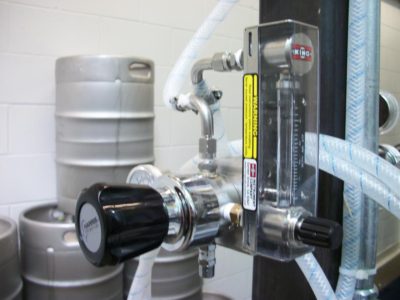
Well the simple answer is oxygen, but more so the lack of!
In our tests and trials we found that in order to preserve that awesome fresh flavor you need to package the beer with DO levels in the parts per billion range. Luckily we have the some of the purest CO2 available to us… And its free!
Oxygen is the enemy for us in this quest so we need to do what we can to make sure as little as possible comes into contact with this glorious beer, especially on the cold side. Yeast is a magnificent oxygen scavenging media so we try and use that as much as possible. That is where the transfer with residual extract comes in. Extract in solution means that the yeast are still active, yeast still active means the yeast will process the O2 for us.
The reason we do this is multifaceted, but there are 2 main points:
1. To make up for our poor purging methods.
2. To carbonate the beer for us.
Lets break these down for some more clarification.
To make up for our poor purging methods.
What does that mean? Well, professional breweries are doing up to 3 vacuum/purge with CO2 cycles to purge their vessels. Unfortunately corny kegs are pretty poor at holding a negative pressure, so that basically means this method will not work for us. Don’t get me wrong, there are methods that could work for purging, but they will be quite cumbersome to implement. This is where the simplicity of spunding comes in. Our best bet is to fill the corny as full as possible with a low oxygen, low foaming (foam contains oxygen!) sanitizer, which for us would be saniclean or Iodiphor. What I do to accomplish this is fill the keg as full as possible with a T from the faucet I made to fill using the in and out posts of the keg. This fills the keg from the posts. I then just open the PRV on the keg, this will fill with water from the inside and when completely full, water will exit the PRV. I then close the PRV and pop off the connectors. I now have a keg that is as full of sanitizer as possible. The keg is then hooked up to a CO2 tank (gas in) and the CO2 is then used to push all the sanitizer out of the liquid out. You are now left with a CO2 filled keg, but that is not good enough because most CO2 contains enough traces of oxygen that if beer was transferred and then force carbed without active yeast, it would push you over the threshold we need to keep, which is below .015 ppm DO.
To carbonate the beer for us.
Knowing what we now about our potential CO2 impurity issues, we will use this residual extract that we have to keep the yeast active to consume any O2 pickup upon our transfer from the fermenter, and then allow it to carbonate the beer with the purest CO2 we can get. We also get the added benefit of rousing the yeast to help you wake them up and help them get you to final gravity, all while capturing some of residual sulfur, which is another great free antioxidant available to us. If you spund you will never need to add any other antioxidants to the beers to help combat cold side oxidation. The residual sulfur will help combat the potential impure CO2 you are using for dispensing, and if you are using a nice Bavarian lager strain you will have plenty. It’s really an all-around win.
It should be noted to transfer as little yeast as possible, i.e. don’t pull from the cake. There will be plenty of yeast left in suspension to get the job done. Too much yeast can lead to issues of autolysis down the road.
So when should you be spunding? Well, we know that the amount of residual extract produced by the fermenting beer is a function of the temperature of fermentation. So if we know the peak temperature achieved prior to spunding, as well as a desired level of carbonation to be achieve, we can estimate the remaining extract necessary to produce that desired level of carbonation. We have a previous write-up on “Bottle Spunding” that goes into the calculations, but at a high level, we can assume the following:
Carbonation (Vol. CO2) needed from extract = Desired Carbonation (Vol. CO2) – Residual Carbonation (Vol. CO2)
Kai outlines the values for carbonation potential of remaining extract here:
Accurately Calculating Sugar Additions for Carbonation
Essentially it breaks down to 1 °P yielding 2 Vol. CO2 or each Specific Gravity point yielding 0.51 Vol. CO2.
We have detailed the process (the article is specific to calculating for bottles but is applicable) in the following article:
The basis for residual carbonation values (calculations presented in this article are in nearly ALL of the online carbonation calculators, our spreadsheet included) is presented in Dr. Michael Hall’s excellent article:
Brew by the Numbers – Add up What’s in Your Beer
Also keep in mind that carbonation calculations are integrated into our spreadsheet.
There is certainly a window, and naturally with slower progressing lager fermentations, you will have more time, so don’t fret if you missed it by a point or 2 in either direction. A FFT is going to help you nail this.